Guide index: Introduction Sites Venues History Restaurants Apartments
Introduction
As a newly minted Roman, I’ve already traversed Piazza Navona more times than I can count. My trips around the city are like small orbits around and through this piazza, since most major sites, popular restaurants and nightlife spots are at most a fifteen-minute walk. Many times, I rush past the piazza, dodging street vendors selling strange blinking toys, slow-moving packs of tourists, and the restaurateurs who can tell in an instant that I’m a foreigner—“Good evening, Miss. Full Meal, fifteen euros”—No thanks.
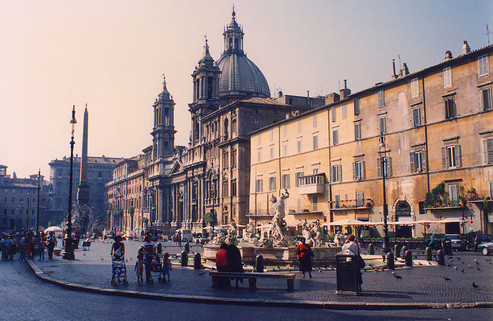 Other times, I am struck by the open space, by the way sounds echo off the buildings, and by the elegance of it all. After wandering around the cramped, narrow web of streets that connect Piazza Navona, Campo dei Fiori, and Piazza Farnese, Piazza Navona is a revelation. Your gaze is forced up from the cobblestones and out across the open space. The splendor of the Baroque facades and towering fountains can survive any assault by the crude commercial forces of tourism.
Other times, I am struck by the open space, by the way sounds echo off the buildings, and by the elegance of it all. After wandering around the cramped, narrow web of streets that connect Piazza Navona, Campo dei Fiori, and Piazza Farnese, Piazza Navona is a revelation. Your gaze is forced up from the cobblestones and out across the open space. The splendor of the Baroque facades and towering fountains can survive any assault by the crude commercial forces of tourism.
Glamour and mystery still survive in web of streets snaking away from Piazza Navona, where many of Rome Lofts’ apartments are located. Via dei Coronari holds some of the best antique shops in the city as well as one of RomeLofts’ most popular apartments. Via del Governo Vecchio is a smorgasbord of ultra-chic designer boutiques, vintage stores filled to the ceiling with clothes, and artisan workshops. Restaurants, osterie and enoteche of every persuasion are scattered throughout the area. Yet even on a Saturday afternoon, I can find quiet streets to explore that seem a galaxy away from the hubbub of the piazza nearby.
Unlike Campo dei Fiori, Piazza Navona is more subdued at night. But, not to fear, those interested in exploring Rome’s nightlife 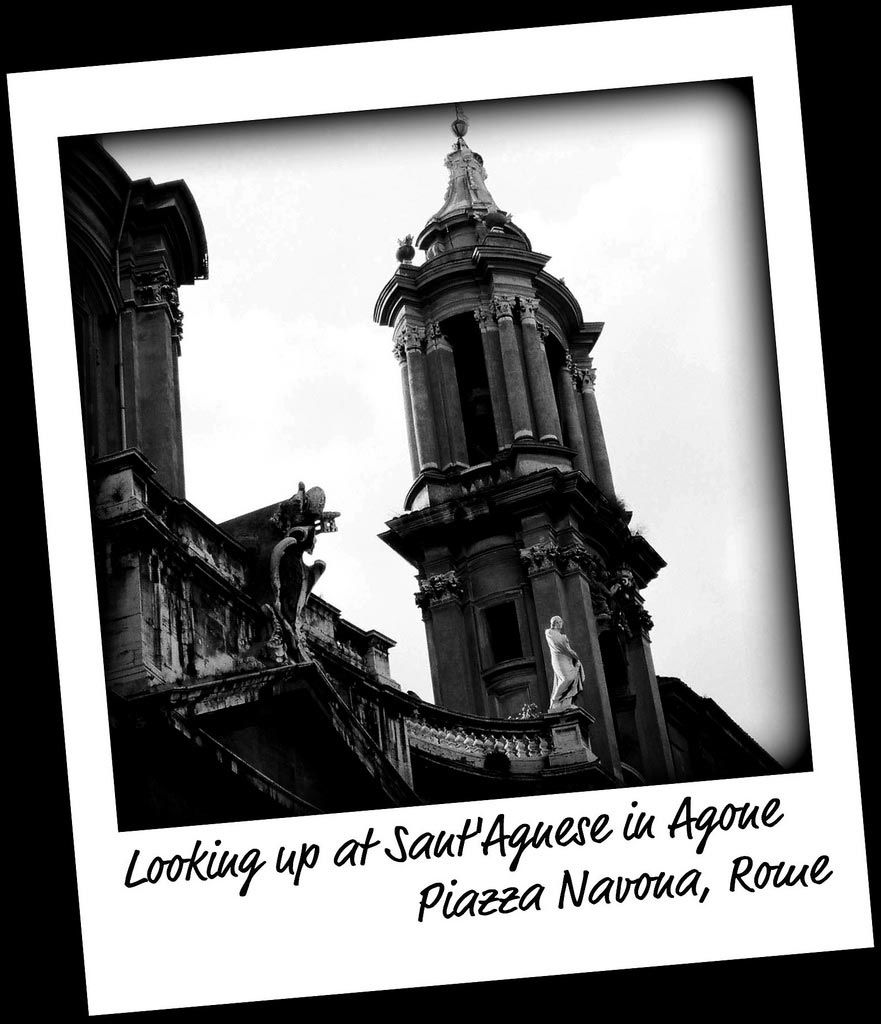 have only to make a short ten-minute walk to Campo dei Fiori for the nightly bar-hopping scene. Or better yet, night owls can check out some of our recommended spots for nightlife in the city. Given Piazza Navona’s central location, most of these locales are easily reachable on foot, bus or taxi.
have only to make a short ten-minute walk to Campo dei Fiori for the nightly bar-hopping scene. Or better yet, night owls can check out some of our recommended spots for nightlife in the city. Given Piazza Navona’s central location, most of these locales are easily reachable on foot, bus or taxi.
Some favorite sites
The Church of Sant’Agnese in Agone is one of the grandest structures on the piazza. According to religious traditions, it stands on the site of the beheading of St. Agnes, a young virgin persecuted by rebuffed suitors. The church now houses her severed skull, called the Sacra Testa (holy head), in its sacristy. I recommend to all to check out the interior of the Church, as well as its headlining (and somewhat baffling—go visit and you’ll understand why) relic.
Of course, Piazza Navona’s centerpiece, Bernini’s Fontana dei Quattro Fiume (Fountain of the Four Rivers), never fails to dazzle visitors with its strange combination of styles—faux ancient Egyptian obelisk and neoclassical sculpture—and characters—four contorted behemoths plus some animals and an imagined armadillo. I can say that there is nothing quite like standing besides the Fontana dei Quattro Fiume late at night, in the rare moment when the Piazza is empty and silent, and watching the bright blue reflections of water dancing across the bodies of the river gods.
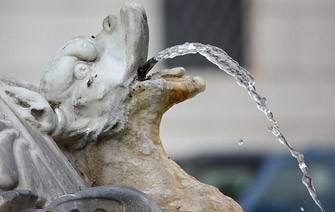 And, though not a site, I would be remiss to forget that during the holiday season, the piazza hosts a Christmas market, where artisans sell typical presepi, figures for manger scenes, and befane, statuettes of Befana, an old witch lady from Italian folklore who delivers present to children on the Feast of the Epiphany. Traditional bagpipers from the Abruzzese mountains also visit the piazza during Christmastime, after making their yearly religious pilgrimage to Rome to play for alms.
And, though not a site, I would be remiss to forget that during the holiday season, the piazza hosts a Christmas market, where artisans sell typical presepi, figures for manger scenes, and befane, statuettes of Befana, an old witch lady from Italian folklore who delivers present to children on the Feast of the Epiphany. Traditional bagpipers from the Abruzzese mountains also visit the piazza during Christmastime, after making their yearly religious pilgrimage to Rome to play for alms.
After walking through cramped, narrow streets in Rome’s center, Piazza Navona is a revelation. The visitor’s gaze is forced up from the cobblestones and out across the grand piazza. Before them, a vast expanse of open space, lined with Baroque facades and dotted with iconic fountains, pulsates with life at all hours of the day and night. In fact, since its creation, Piazza Navona has been a hub of spectacle. In ancient times, it was a circus in the literal sense. These days, it’s a spectacle of Roman city life, of art, of commerce, and of socializing.
Some favorite venues
Here are some personal recommendations from the staff at Rome Loft, all longtime residents of Rome, and some of my own favorites, too.
Macheroni Piazza della Copelle 44. Tel. 06 6830 7895. The perfect casual Roman restaurant that serves up simple but excellent pastas and steaks. Always full with Romans and visitors. Full meal around €25.
L’Orso 80 Via dell’Orso 33. Tel 06 686 4904. Tucked away little spot to the north of the piazza. Recommended for its breadth of Roman specialties like fried zucchini fingers, baby artichokes, and ricotta cake. Full meal around € 30.
Casa Bleve Via del Teatro Valle 48-49. Tel. 06 686 5970. A decadent enoteca that fills the ground floor of a 16th-century palazzo. Lucky patrons get to peek at the wine vault, housed in the first-century building foundations. Full meal €60.
La Rossetta Via della Rossetta, 8-9. Tel. 06 686 1002. For those with some money to burn and a refined palate. Widely reviewed as one of Rome’s best seafood restaurants. Fixed menus starting around €100.
L’Eau Vive Via Monterone 85. Tel. 06 688 010 95. An idiosyncratic alternative to more pizza and pasta, this French restaurant is run by an international lay sisterhood of missionary Christians, who occasionally interrupt meals to sing religious songs or stage short biblically inspired ballets. Fixed price menus from €14-30.
CO2 Largo del Teatro Valle, 4. Tel. 06 4547 6337. Brasserie by weekday, brunch paradise on Sunday mornings. For all those foreigners hankering for a proper (if not enormous) morning meal. Brunch buffet €25.
Caffè della Pace V. della Pace 3-7. Tel. 06 686 1216. A classy spot for an afternoon tea, evening aperitivo or a night cap. Open daily until 2am.
Sant’Eustachio Il Caffè P. di Sant’Eustachio 82. Tel. 06 6880 2048. One of the most venerated caffes in Rome, it cultivates an air of mystery by shielding the drink preparations from view.
Cul De Sac. Piazza Pasquino 73. Tel. 06 68 801 094.ne of Rome’s first and most well-regarded wine bars. 1400 choices of wines. Also a restaurant.
Some history
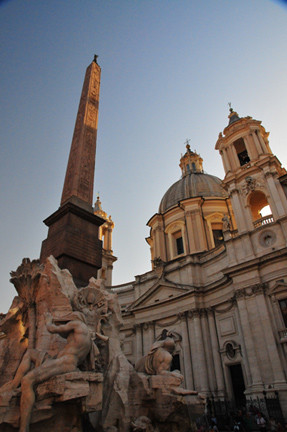 In fact, the very space of Piazza Navona was forged by the crude pursuit of spectacle, when Emperor Domition built a stadium, Circus Agonalis, for gladiatorial games and races. Like most structures in Ancient Rome, the Circus fell into disrepair following a succession of invasions during the Dark Ages. Residents began pilfering pieces of stone for their own building purposes. Luckily, visitors to the Piazza can still see some of the stadium’s foundations if they navigate to a small doorway in the northern part of nearby Piazza di Tor Sanguigna.
In fact, the very space of Piazza Navona was forged by the crude pursuit of spectacle, when Emperor Domition built a stadium, Circus Agonalis, for gladiatorial games and races. Like most structures in Ancient Rome, the Circus fell into disrepair following a succession of invasions during the Dark Ages. Residents began pilfering pieces of stone for their own building purposes. Luckily, visitors to the Piazza can still see some of the stadium’s foundations if they navigate to a small doorway in the northern part of nearby Piazza di Tor Sanguigna.
As human activity eroded the structure of the once-great stadium, enough space became available to hold public markets from 1477 to 1869. In this less formal setting, brave souls continued to compete for honor and entertainment, in jousts and in such contests as the albero della cuccagna, where sufficiently dexterous men would race up a greased pole to retrieve a ham.
During the Renaissance, a rivalry more fit for a circus ring than the Church emerged from St. Peters to shape Piazza Navona into its present form. After the 21-year reign of Pope Urban VIII, a powerful leader from the Barberini family who refashioned many areas of Rome to his liking, Pope Innocent X was eager to escape his predecessor’s shadow when he became the pontiff in 1644. To garner public admiration and to distract attention from Urban VIII’s accomplishments, Innocent X cleared the space of Piazza Navona once and for all and commenced constructing the grandiose palaces, churches and fountains that remain the main features of the piazza today. Anecdotes about this papal rivalry, and the rivalry of their favorite artists, Bernini and Borromini, have had tremendous staying power in popular imagination, regardless of their factual accuracy.
In ancient Roman times, the Circus Agonalis, a 30,000-spectator venue built by Emperor Domition in the first century BC, rose above what is now the piazza’s oblong open space. There, Domitian and his successors held athletic contests in the nude Greek fashion and all manner of races. Occasionally, they would flood the stadium to hold mock naval battles, and even hosted some gladiatorial matches when the Coliseum was hit by lightning at the beginning of the third century AD.
Like many institutional structures in Ancient Rome, the Circus fell into disrepair following a succession of invasions during the 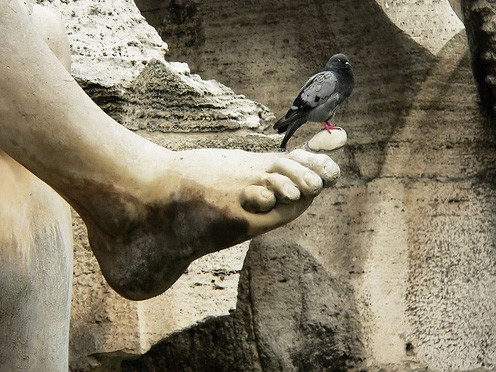 Dark Ages. Residents began pilfering pieces of stone for their own building purposes. Visitors to the Piazza can still see some of the stadium’s foundations if they navigate to a small doorway in the northern part of nearby Piazza di Tor Sanguigna, where they must look over a railing and down eight meters below street level to view the ancient stones. In the summer of 2009, the Commune of Rome even began offering guided tours of the underground ruins of the stadium.
Dark Ages. Residents began pilfering pieces of stone for their own building purposes. Visitors to the Piazza can still see some of the stadium’s foundations if they navigate to a small doorway in the northern part of nearby Piazza di Tor Sanguigna, where they must look over a railing and down eight meters below street level to view the ancient stones. In the summer of 2009, the Commune of Rome even began offering guided tours of the underground ruins of the stadium.
As human activity eroded the structure of the once-great stadium, enough space became available to hold public markets from 1477 to 1869. In this less formal setting, brave souls continued to compete for honor and entertainment, in justs and in such contests as the albero della cuccagna, where sufficiently dexterous men would race up a greased pole to retrieve a ham. On hot Sundays, the space was flooded to provide some respite from oppressive heat for animals and people alike. This practice continued up until the 19th century.
During the Renaissance, a rivalry more fit for a circus ring than the Church emerged from St. Peters to shape Piazza Navona into its present form. After the 21-year reign of Pope Urban VIII, a powerful leader from the Barberini family who refashioned many areas of Rome to his liking, Pope Innocent X was eager to escape the shadow of his predecessor when he became the pontiff in 1644. To garner public admiration and to distract attention from Urban VIII’s accomplishments, Innocent X cleared the space of Piazza Navona once and for all and commenced constructing the grandiose palaces, churches and fountains that remain the main features of the piazza today.
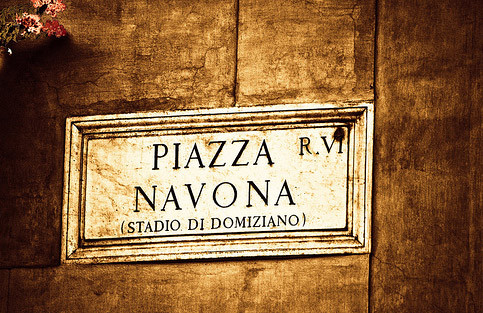 Anecdotes about this papal rivalry, and the rivalry of their favorite artists, Bernini and Borromini, have had tremendous staying power in popular imagination, regardless of their factual accuracy. One anecdote contends that Pope Innocent X diverted all the water from Piazza Barberini’s Fontana del Tritone to Bernini’s Fontana dei Quattro Fiumi (Fountain of the Four Rivers). Another tells of how in that very fountain, Bernini designed the river gods of the Nile and the Rio Plata to shield their eyes from the Church of St. Agnese in Agone, which constructed by his archrival Borromini. In return, legend holds that Borromini designed his statue of St. Agnes to look across and beyond the piazza, not down on his rival’s fountain. The fountain, in fact, was designed and completed before Borromini ever received the commission for the Church of Santa Agnese. Nonetheless, these legends remain a beloved part of the lore of Piazza Navona, passed down over the centuries by Romans enamored of their colorful history.
Anecdotes about this papal rivalry, and the rivalry of their favorite artists, Bernini and Borromini, have had tremendous staying power in popular imagination, regardless of their factual accuracy. One anecdote contends that Pope Innocent X diverted all the water from Piazza Barberini’s Fontana del Tritone to Bernini’s Fontana dei Quattro Fiumi (Fountain of the Four Rivers). Another tells of how in that very fountain, Bernini designed the river gods of the Nile and the Rio Plata to shield their eyes from the Church of St. Agnese in Agone, which constructed by his archrival Borromini. In return, legend holds that Borromini designed his statue of St. Agnes to look across and beyond the piazza, not down on his rival’s fountain. The fountain, in fact, was designed and completed before Borromini ever received the commission for the Church of Santa Agnese. Nonetheless, these legends remain a beloved part of the lore of Piazza Navona, passed down over the centuries by Romans enamored of their colorful history.
The Church of St. Agnese in Agone hosts the relics of a different type of lore. According to religious traditions, the church stands on the site of a bordello where rebuffed suitors brought St. Agnese to shame her. Still enraged, they then stripped her naked in Domitian’s stadium. Miraculously, her hair grew to cover her nudity. Her persecutors persevered, trying to burn her at the stake, but she would not burn. Diocletian, the emperor at the time, lost his patience and then had her beheaded. The church now houses her severed skull, called the Sacra Testa (holy head), in its sacristy.
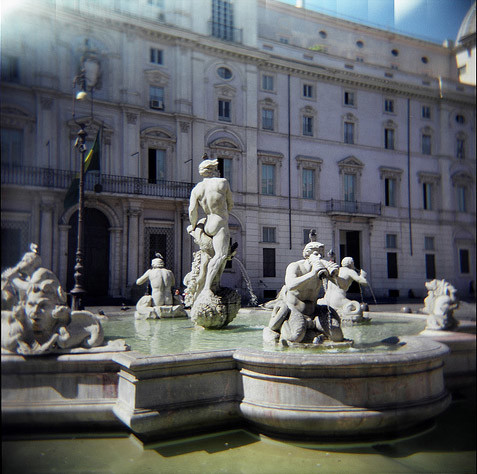 These stories of antagonism, part legend, part history, are thankfully far from the activities found in Piazza Navona today. On any given day, visitors can find portrait artists, street vendors, multi-lingual fortunetellers, artisans, promoters, and restaurateurs competing for the attention of students, tourists, and Romans passing by. The web of streets and alleys surrounding the Piazza hold some of the best boutiques, restaurants, and artisanal workshops in the city. Via del Governo Vecchio is particularly noteworthy for its vintage and antique shops. During the holiday season, the piazza also hosts a Christmas market, where artisans sell typical presepi (figures for manger scenes), and befane (statuettes of Befana, an old witch lady from Italian folklore who delivers present to children on the Feast of the Epiphany).
These stories of antagonism, part legend, part history, are thankfully far from the activities found in Piazza Navona today. On any given day, visitors can find portrait artists, street vendors, multi-lingual fortunetellers, artisans, promoters, and restaurateurs competing for the attention of students, tourists, and Romans passing by. The web of streets and alleys surrounding the Piazza hold some of the best boutiques, restaurants, and artisanal workshops in the city. Via del Governo Vecchio is particularly noteworthy for its vintage and antique shops. During the holiday season, the piazza also hosts a Christmas market, where artisans sell typical presepi (figures for manger scenes), and befane (statuettes of Befana, an old witch lady from Italian folklore who delivers present to children on the Feast of the Epiphany).
Here are some other favorite locales, personally selected by the staff of Rome Loft.
Restaurants:
- Taverna Parione A local favorite for Roman fare. Via di Parione 38/39, tel. 066869545. €20-35 for a meal, credit cards accepted. Air-conditioned.
- L’Hostaria dell’Orso More typical Roman cuisine, this time enhanced by the beauty of its location inside a 14th century palazzo. Via dei Soldati 25c, tel. 0668301192. Closed on Sunday. €35-50 for a meal, credit cards accepted. Air-conditioned.
Pizzerias:
- Da Baffetto. Famous historical pizzeria in Rome. Via del Governo Vecchio 114, tel. 066861617. €10-12 for a meal, credit cards accepted. Reservations advised.
- Ai Balestrari. Pizzas and typical cuisine. Via dei Balestrari 41, tel. 066865377. Closed on Monday. €15-20 for a meal, credit cards accepted.
Wine:
- L’Angolo Divino. 1000 choices of Italian and international wines, refined cuisine. Via dei Balestrari 12, tel. 066864413. Closed on Monday.
- Al Bric. 1000 choices of Italian wines. Via del Pellegrino 51, tel. 066879533. Closed on Monday.
- Cul De Sac. 1400 choices of wines. Also restaurant. Piazza Pasquino 73, tel. 0668801094.
Cafés:
- Antico Caffé della Pace. A café and tea room, this is a popular meeting place for intellectuals and artists. Via della Pace 4/7, tel. 066861216. Open from 9am to 2am.
- Tre Scalini. Open from 9am to 1:30am. Very appreciated for the ice cream, it’s also restaurant. Piazza Navona 28, tel 0668801996.
- Bramante Ideal after a visit to the art exhibitions at Chiostro del Bramante. Great views of a small, ivy-draped square. Via della Pace 25, tel. 0668803916.
Cinemas:
- Cinema Farnese Piazza Campo dei Fiori 56, tel. 066864395.
At night:
- Abbey Theatre Pub, italian/irish cuisine, celtic music live. Via del Governo Vecchio 51/53, tel. 066861341. Open from 8pm-2am.
- Henry’s Pub Via di Tor Milina 34, tel. 066869904. Open from 7pm-3:30am. Closed on Monday.
- Femme Closed on Sunday and Monday. Disco pub with three rooms: cocktailbar, disco, lounge. Via del Pellegrino 14, tel. 066864862. Open from 6pm-2am.
- Auditorium del Gonfalone Classical music concerts in a 16th century painted with frescos church.
- Via del Gonfalone 32/a, tel. 0685301758.
International Bookstore:
- Feltrinelli Largo di Torre Argentina 11, tel. 0668663001. Open Mon-Fri from 9am-9pm, Sat
from 9am-11pm, Sun from 10am-8pm. Also music store.
Market places:
- Campo dei Fiori The most well known and charming open-air food market. Open from 7am-2pm. Closed on Sunday.
Supermarket-alimentari:
- Despar Via Della Moretta 10. Open Mon-Sat from 8am-9pm, Sun from 9am-9pm.
- Despar Corso Vittorio Emanuele II 42. Open Mon-Sat from 8am-9pm, Sun from 9am-9pm.
Guide index: Introduction Sites Venues History Restaurants Apartments
